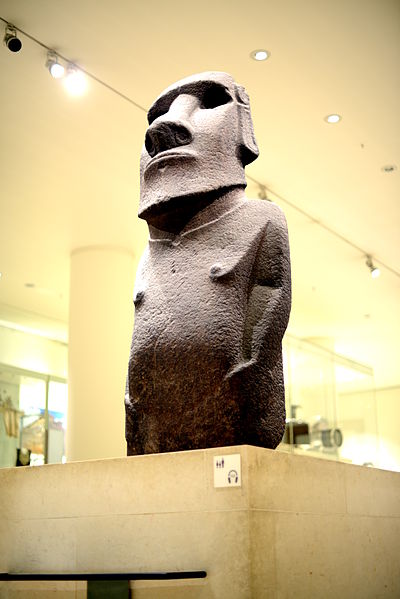Hoa Hakananai'a

Hoa Hakananai'a in the Wellcome Gallery.
|
|
| Material | Flow lava |
|---|---|
| Size | Height: 2.42 metres (7.9 ft) |
| Created | c. 1000-1600 CE |
| Place | 'Orongo ceremonial centre, Rapa Nui (Easter Island) |
| Present location | British Museum, London, Gallery 24 |
| Registration | 1869,1005.1 |
Hoa Hakananai'a is a moai (Easter Island statue) housed in the British Museum in London. It was taken from ‘Orongo, Rapa Nui (Easter Island) in November 1868 by the crew of the British ship HMS Topaze, and arrived in England in August 1869. Though relatively small, it is considered to be typical of the island’s statue form, but distinguished by carvings added to the back, associated with the island birdman cult. It has been described as a "masterpiece", "without a doubt, the finest example of Easter Island sculpture".
The statue was identified as Hoa Hakananai'a by islanders at the time it was removed, the British crew first recording the name in the form Hoa-haka-nana-ia or Hoa-haka-nama-ia. It has been variously translated from the Rapa Nui language (Polynesian) to mean breaking wave,surfriding,surfing fellow or master wave-breaker; and lost or stolen friend,stolen friend or hidden friend or doing robberies/mockeries friend.
When recorded in 1868, Hoa Hakananai'a was standing erect, part buried inside a freestone ceremonial "house" in the ‘Orongo village at the south-western tip of the island. It faced towards an extinct volcanic crater known as Rano Kau, with its back turned to the sea. It may have been made for this location, or first erected elsewhere before being moved to where it was found.
Most statues on Rapa Nui are of a reddish tuff, but Hoa Hakananai'a is made from a block of dark grey-brown flow lava. Though commonly described as basalt, quarried near to where the statue was found, there is no record of petrological analysis to confirm this. It stands 2.42 metres (7.9 feet) high, is 96 cm (3.15 ft) across, and weighs 4.2 tonnes.
The base of the statue, now concealed in a modern plinth, may originally have been flat, and subsequently narrowed, or was rough and tapering from the start.
Typical of Easter Island moai, Hoa Hakananai'a features a heavy brow, blocky face with prominent nose and jutting chin, nipples, thin, lightly angled arms down the sides and hands reaching towards the stomach, which is near the base. It has a raised Y-shape in the centre of the chin, eyes hollowed out in a way characteristic of statues erected elsewhere on the island on ceremonial ahu platforms, and long, rectangular stylised ears. A line around the base of the neck is interpreted as representing the clavicles; there is a semi-circular hollow for the suprasternal notch.
...
Wikipedia
